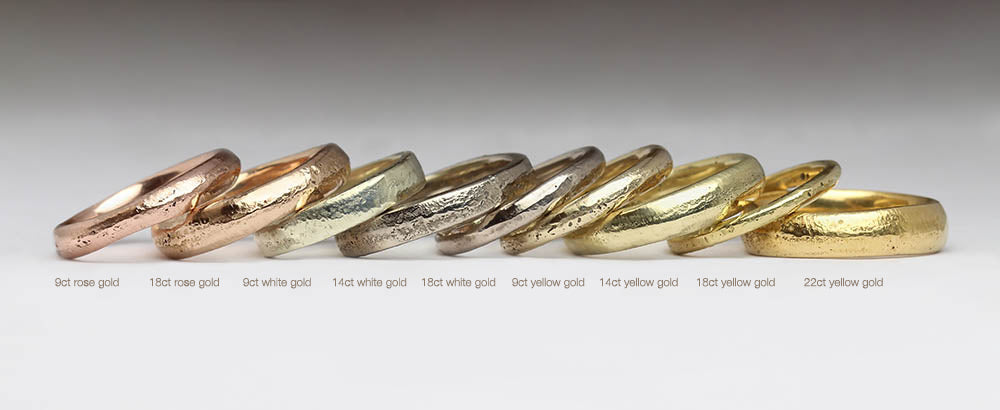Choosing your Colour of Gold
Baffled by how to choose the colour of gold for you? Understanding the different colours and carats can really help.
 When choosing the carat and colour of gold for their wedding rings, people often focus on strength. While this is certainly an important aspect, don’t let it distract you from choosing the colour of gold you like the most. Each carat of gold has a different colour tone due to the quantity of pure gold it contains, and which other metals it’s alloyed with. As we only use recycled gold, there is sometimes a subtle change in tone from one ring to another. This can happen even if they’re the same carat and colour of gold. It is all part of what makes our sandcast rings so unique. Our signature matte finish (displayed in the picture above) shows off the natural colours of the metals to their best advantage. An antique polish finish makes the colour differences more subtle and gives the rings a lovely shine, as you can see here:
When choosing the carat and colour of gold for their wedding rings, people often focus on strength. While this is certainly an important aspect, don’t let it distract you from choosing the colour of gold you like the most. Each carat of gold has a different colour tone due to the quantity of pure gold it contains, and which other metals it’s alloyed with. As we only use recycled gold, there is sometimes a subtle change in tone from one ring to another. This can happen even if they’re the same carat and colour of gold. It is all part of what makes our sandcast rings so unique. Our signature matte finish (displayed in the picture above) shows off the natural colours of the metals to their best advantage. An antique polish finish makes the colour differences more subtle and gives the rings a lovely shine, as you can see here: 
Carat
To understand why the different carats and colours of gold all look so different, it’s best to start with the carats. Carats denote the amount of pure gold a piece of jewellery contains and is measured in parts per thousand. Therefore, how many parts are pure gold will equal the hallmark your jewellery receives. 9ct – 37.5% (375) 14ct – 58.5% (585) 18ct – 75% (750) 22ct – 91.6% (916) Each piece will be ‘assayed’ (tested) and hallmarked at one of four Assay Offices in the UK. We send all of our jewellery to the Birmingham Office.
Yellow Gold
The higher the carat the brighter the yellow colour and the warmer the piece is. This is because the higher carats contain more pure gold. In yellow gold this intensifies the yellow colour as you go up through the carats.
9ct yellow gold has a lovely soft, sandy colour due to its lower gold content. This softness of hue makes it a more subtle choice.
14ct yellow gold is a popular carat in the States and is a rather unique yellow colour, which is almost limey in tone. It is the exception to the rule – it’s a brighter colour but the distinctive almost luminous tone separates it from the crowd.
18ct yellow gold is a much brighter and richer butter-yellow colour. It also begins to get noticeably weightier than the other carats too, as it contains a lot more gold.
22ct yellow gold is the highest carat of gold we use. It's also only available in a yellow gold as there isn’t enough scope (only 8.4%) to add another metal which will change the colour. 22ct is a gorgeous, rich yellow colour, which is almost orange-y in its richness. Think pirate gold, and you’ll think of 22ct!

White Gold
White gold is made by the addition of silver and palladium as main alloys. As with yellow gold, each carat contains different proportions of metals which changes the colours. It is also often rhodium plated to make it appear even more white. We don’t plate our white gold unless requested, choosing instead to celebrate its natural colours and saving you from worrying about re-plating down the line.
9ct white gold is very similar in colour to silver and can be hard to tell apart at first glance. It does contain quite a bit of silver (which is what makes it ‘white’), but it has a warmer creamy colour due to the gold content. The colour difference is more apparent when compared side by side with a piece of silver jewellery.
14ct white gold is a dramatically different colour to 9ct white gold. It’s a lovely warm grey, which is a result of being alloyed with palladium as well as silver. Palladium is a very strong metal and only a small amount is needed to dominate the purer gold content and change the colour. 14ct white gold still has a slightly golden undertone though, which is easy to see if you compare it with a truly grey metal, like pure palladium or platinum.
18ct white gold has a lovely light grey colouring, with a champagne hint of gold showing through. This is less visible when polished, as then the metal takes on a shiny, deep silver colour.

Rose Gold
Rose gold obtains its beautiful red colour from the copper it’s alloyed with. The lower the carat, the more copper it contains.
9ct rose gold is a lovely deep rosy colour. It’s about as red as it will get – and is often chosen for its warmth and depth of colour.
18ct is more subtle than 9ct rose gold as it has a much lower copper content. Because of this, its colour is a softer blush of pink that’s almost coral-like in tone.

Still not sure about choosing your colour of gold?
Book an appointment to come and visit the workshop and try some on! Contact us here.




